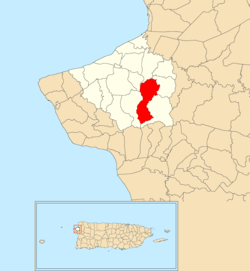Naranjo, Aguada, Puerto Rico
Naranjo | |
|---|---|
Barrio | |
 Location of Naranjo within the municipality of Aguada shown in red | |
| Coordinates: 18°20′43″N 67°09′28″W / 18.345381°N 67.157669°W[1] | |
| Commonwealth | |
| Municipality | |
| Area | |
• Total | 2.72 sq mi (7.0 km2) |
| • Land | 2.72 sq mi (7.0 km2) |
| • Water | 0.00 sq mi (0.0 km2) |
| Elevation | 269 ft (82 m) |
| Population (2010) | |
• Total | 3,292 |
| • Density | 1,210.3/sq mi (467.3/km2) |
| Source: 2010 Census | |
| Time zone | UTC−4 (AST) |
Naranjo is a barrio in the municipality of Aguada, Puerto Rico. Its population in 2010 was 3,292.[3][4][5]
History
Puerto Rico was ceded by Spain in the aftermath of the Spanish–American War under the terms of the Treaty of Paris of 1898 and became a territory of the United States. In 1899, the United States conducted its first census of Puerto Rico finding that the population of Naranjo barrio was 923.[6]
| Census | Pop. | Note | %± |
|---|---|---|---|
| 1980 | 2,618 | — | |
| 1990 | 3,087 | 17.9% | |
| 2000 | 3,724 | 20.6% | |
| 2010 | 3,292 | −11.6% | |
| U.S. Decennial Census[7] 1899 (shown as 1900)[8] 1910-1930[9] 1930-1950[10] 1980-2000[11] 2010[12] | |||
Sectors
Barrios (which are like minor civil divisions)[14] in turn are further subdivided into smaller local populated place areas/units called sectores (sectors in English). The types of sectores may vary, from normally sector to urbanización to reparto to barriada to residencial, among others.[15][16][17][18]
The following sectors are in Naranjo barrio:[19]
Sector 3 Copas, Sector Berto Vargas, Sector Ceferino Acevedo, Sector Cuchilla, Sector El Coquí, Sector El Lirio, Sector El Manantial, Sector Foro Soto, Sector González, Sector Guillermo Matías, Sector Juan Tita, Sector La Cadena, Sector Lencho Pérez, Sector Leo Fora, Sector Militar, Sector Mingo Echevarría, Sector Moncho Pérez, Sector Naranjo Abajo, Sector Naranjo Arriba, and Sector Tano Villarrubia.
In Naranjo barrio is part of the Luyando community.[5]
See also
References
- ^ a b "US Gazetteer 2019". US Census. US Government.
- ^ U.S. Geological Survey Geographic Names Information System: Naranjo Barrio
- ^ Picó, Rafael; Buitrago de Santiago, Zayda; Berrios, Hector H. Nueva geografía de Puerto Rico: física, económica, y social, por Rafael Picó. Con la colaboración de Zayda Buitrago de Santiago y Héctor H. Berrios. San Juan Editorial Universitaria, Universidad de Puerto Rico,1969.
- ^ Gwillim Law (20 May 2015). Administrative Subdivisions of Countries: A Comprehensive World Reference, 1900 through 1998. McFarland. p. 300. ISBN 978-1-4766-0447-3. Retrieved 25 December 2018.
- ^ a b Puerto Rico:2010:population and housing unit counts.pdf (PDF). U.S. Dept. of Commerce, Economics and Statistics Administration, U.S. Census Bureau. 2010.
- ^ Joseph Prentiss Sanger; Henry Gannett; Walter Francis Willcox (1900). Informe sobre el censo de Puerto Rico, 1899, United States. War Dept. Porto Rico Census Office (in Spanish). Imprenta del gobierno. p. 160.
- ^ "U.S. Decennial Census". United States Census Bureau. Archived from the original on February 13, 2020. Retrieved September 21, 2017.
- ^ "Report of the Census of Porto Rico 1899". War Department Office Director Census of Porto Rico. Archived from the original on July 16, 2017. Retrieved September 21, 2017.
- ^ "Table 3-Population of Municipalities: 1930 1920 and 1910" (PDF). United States Census Bureau. Archived (PDF) from the original on August 17, 2017. Retrieved September 21, 2017.
- ^ "Table 4-Area and Population of Municipalities Urban and Rural: 1930 to 1950" (PDF). United States Census Bureau. Archived (PDF) from the original on August 30, 2015. Retrieved September 21, 2014.
- ^ "Table 2 Population and Housing Units: 1960 to 2000" (PDF). United States Census Bureau. Archived (PDF) from the original on July 24, 2017. Retrieved September 21, 2017.
- ^ Puerto Rico:2010:population and housing unit counts.pdf (PDF). U.S. Dept. of Commerce Economics and Statistics Administration U.S. Census Bureau. 2010. Archived (PDF) from the original on 2017-02-20. Retrieved 2019-08-02.
- ^ "Population and Housing Unit Estimates". United States Census Bureau. Retrieved September 21, 2017.
- ^ "US Census Barrio-Pueblo definition". factfinder.com. US Census. Archived from the original on 13 May 2017. Retrieved 5 January 2019.
- ^ Mari Mut, José A. (28 August 2013). "Los pueblos de Puerto Rico y las iglesias de sus plazas" (in Spanish). Retrieved 19 June 2020 – via archive.org.
- ^ "Agencia: Oficina del Coordinador General para el Financiamiento Socioeconómico y la Autogestión (Proposed 2016 Budget)". Puerto Rico Budgets (in Spanish). Retrieved 28 June 2019.
- ^ Rivera Quintero, Marcia (2014), El vuelo de la esperanza : Proyecto de las Comunidades Especiales Puerto Rico, 1997-2004 (first ed.), San Juan, Puerto Rico Fundación Sila M. Calderón, ISBN 978-0-9820806-1-0
- ^ "Leyes del 2001". Lex Juris Puerto Rico (in Spanish). Retrieved 23 June 2020.
- ^ "DESGLOSE DE SECTORES Y CENTROS DE VOTACIÓN PRECINTO ELECTORAL - AGUADA 038" (PDF). Comisión Estatal de Elecciones Puerto Rico (in Spanish). 28 October 2019. Retrieved 15 June 2020.
External links

